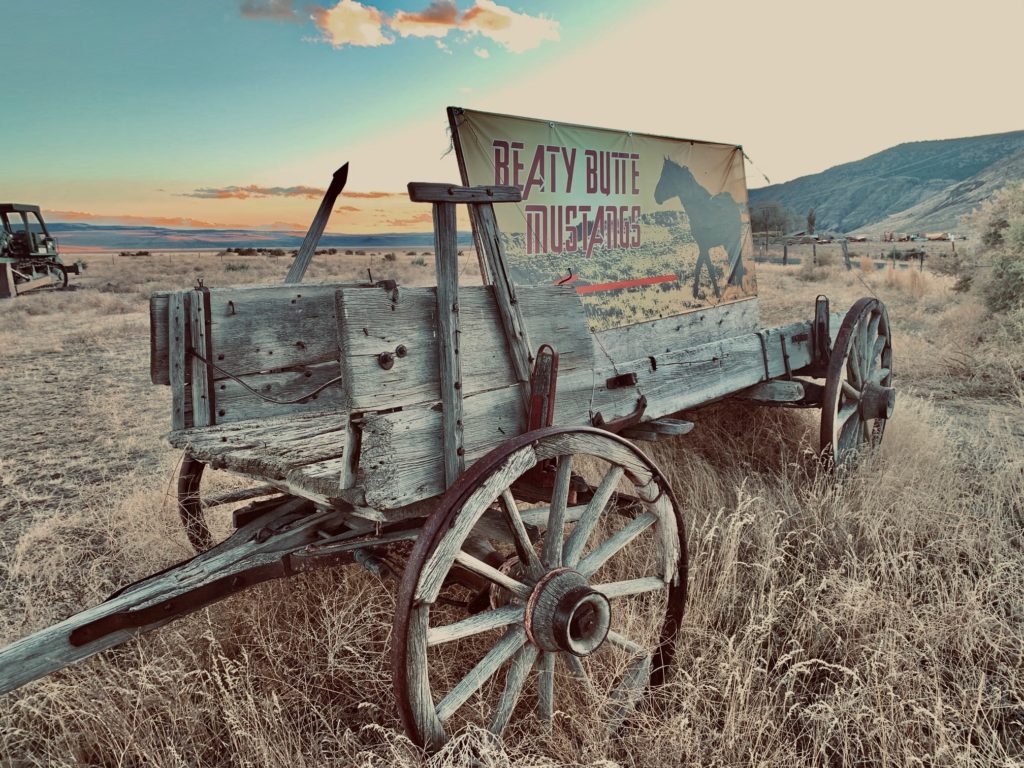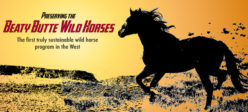 Beaty Butte Herd Management Area
Beaty Butte Herd Management Area
437,120 acres AML: 100-250 horses.
Forage is allocated for 100 to 250 wild horses in the Beaty Butte HMA.
Horses are managed for quality and conformation. Horses are of almost every color, although officially the herd is managed for dun. Many foundation horses for the Kiger HMA came from Beaty Butte. The Beaty Butte horses are reputed to have extremely good minds and temperaments.
Size range: 14 to 16 hands and weigh 950-1300 pounds.
Beaty Butte HMA has been periodically gathered since 1984. Numbers of wild horses captured and removed for each successive gather are documented in the Lakeview District Office. The 2007 gather removed 255 wild horses. A July 24, 2009 census showed the population within the Beaty Butte HMA to be 256, including 204 adults and 51 foals under one year of age. 189 horses were counted on the adjoining Hart Mountain National Wildlife Refuge; of these 157 were adults and 39 were foals under 1 year of age.
Adult wild horses in the HMA weigh an average of 950 to1,050 pounds and stand between 14.2 and 15.2 hands, with some stallions being slightly larger. The herd is managed for horses with dun color markings. Other common colors within the herd include black, bay, brown, and roans. Most have saddle horse type conformation with some Spanish horse characteristics. Peak foaling period for these herds is from March through May. Peak breeding period is from April through June. Water is a limiting factor in certain years throughout the Beaty Butte HMA. Most of the watering areas in the HMA are in the form of seasonal reservoirs and springs that provide water during the spring through fall seasons or until they dry up.
A long history of horses drifting into and out of the Beaty Butte HMA exists. There is movement between Sheldon and Hart National Wildlife Refuge, private land and the Burns District HMAs including Warm Springs and South Steens. ”
http://www.blm.gov/…/files/Beatys_Butte_EA_FONSI_DR.pdf
A Beaty Butte gather began 9/15/09 and concluded 9/26/09. They planned to gather 683 but actually only gathered 423, with 379 horses permanently removed and 44 being released back into the range.
In summer of 2015, census counted 1500 horses living on Beaty Butte and surrounding areas (Hart Mountain, etc) which, combined with 4 years of protracted drought, resulted serious range degradation and risk of starvation to the horses.
In fall of 2015, 1070 horses were gathered.
| State Herd Area: Beaty Butte (OR) |
| BEATY BUTTE HERD MANAGEMENT AREAThe Beaty Butte Herd Management Area (HMA) consists of a total of 437,120 acres, including 396,520 acres of federal, 640 acres of state, and 37,040 acres of privately owned land. The area is located 65 miles east of Lakeview, Oregon. It is adjacent to and southeast of the Hart Mountain National Antelope Refuge, is southwest of Catlow Valley, and is bordered on the South by the Charles Sheldon National Antelope refuge in Nevada. Vegetation is primarily sagebrush steppe consisting of big sagebursh and bunchgrasses. Low sagebrush communities are interspersed throughout the area. Topography varies from gently rolling hills to steep rugged hills and buttes with a number of broad valleys and shallow or dry lakebeds. Slopes range from 0 to 60%. Precipitation averages 9 inches annually mainly from winter snowfall. Summers are short, warm and dry while winter are typically long and cold.
Beaty Butte, located in the north-central part of the area is the most prominent landmark. Its elevation of 7,885 feet above sea level makes it the highest point in the Lakeview Resource Area. There is a complex of smaller buttes surrounding Beaty Butte including, Lone Grave (elevation 6510), Shirk’s Lookout (elevation 6784), Mahogany Butte (elevation 7140), Sagehen Butte (elevation 6172) and Antelope Butte (elevation 6410) in the southwest part of the HMA. In the southeast, Acty Mountain (elevation 6980) and Hawk Mountain are prominent landmarks. Portions of five Wilderness Study Areas (WSAs) fall within the boundary of the HMA. These include, Spaulding, Hawk Mountain, Sage Hen Hills, Rincon, and Basque Hills WSAs. The area has a wide diversity of wildlife habitats and species including resident, migratory and nomadic populations. Large mammals include California bighorn sheep, pronghorn antelope and mule deer. Animals typical in the area are coyote, raven, red-tailed hawk, American kestrel, prairie falcon, turkey vulture, rough-legged hawk, chukar partridge, valley quail, mourning dove, Northern harrier, common crow, magpie, great horned owl, mountain lion, bobcat, great basin fence lizard and rattlesnake. Numerous small mammals in the area include least chipmunk, pocket gopher, ground squirrels, a variety of native mice and vole. Wetland habitat also supports numerous species of ducks, geese, swans, and shorebirds. There are 8 animal species in the area which have special status including the Bald Eagle, Loggerhead Shrike, California Bighorn Sheep, Pygmy Rabbit, Long-billed Curlew, Ferruginous Hawk, White-tailed antelope squirrel, and the White-tailed Jackrabbit. Appropriate management levels for the Beaty Butte HMA are 100-250 horses. Horses are of almost every color and genetic background. The majority of horses are sorrels, browns, roans, and greys. A few horses show characteristics of Spanish mustangs, other bloodlines include draft horses, saddle type, and thoroughbred. Horses are managed for quality and conformation. Adult horses range from 14 to 16 hands and weigh 950-1300 pounds. |
